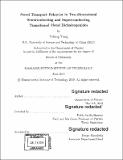| dc.contributor.advisor | Pablo Jarillo-Herrero. | en_US |
| dc.contributor.author | Yang, Yafang,Ph. D.Massachusetts Institute of Technology. | en_US |
| dc.contributor.other | Massachusetts Institute of Technology. Department of Physics. | en_US |
| dc.date.accessioned | 2020-01-08T19:41:36Z | |
| dc.date.available | 2020-01-08T19:41:36Z | |
| dc.date.copyright | 2019 | en_US |
| dc.date.issued | 2019 | en_US |
| dc.identifier.uri | https://hdl.handle.net/1721.1/123397 | |
| dc.description | Thesis: Ph. D., Massachusetts Institute of Technology, Department of Physics, 2019 | en_US |
| dc.description | Cataloged from PDF version of thesis. | en_US |
| dc.description | Includes bibliographical references (pages 149-163). | en_US |
| dc.description.abstract | Atomically layered transitional metal dichalcogenides (TMDs) manifest many fascinating properties such as atomic-scale thickness, favorable mechanical, electronic and optoelectronic properties and strong spin-orbit coupling. In terms of electronic properties, the TMDs range from insulating or semiconducting to metallic or semi-metallic. Some of them also exhibit exotic electronic phases such as charge density waves and superconductivity. Recent advances in nano-materials characterization and device fabrication, in particular, fabrication of high quality van der Waals heterostructures, have boosted studies on two-dimensional layers of thin TMDs for purpose of both fundamental research and industrial applications. In this thesis, I present a series of experiments investigating electronic and optoelectronic properties of semiconducting TMDs MoS2 and WSe2. I also demonstrate technical advances in fabrication of van der Waals heterostructures, which enables high-quality encapsulated thin TMDs devices with ionic liquid introduced as electrolyte. I further show that phase transitions in superconducting TMDs such as 2H-TaS2 can be greatly impacted by dimensionality reduction. A substantial enhancement of superconducting T, and a suppression of the CDW transition are observed in 2H-TaS2 in the 2D limit. At last, I present a machine learning algorithm to realize pixel-wise classification on laboratory acquired images of various 2D materials, which might open up new opportunities for full automation of nano-material search and device fabrication. | en_US |
| dc.description.statementofresponsibility | by Yafang Yang. | en_US |
| dc.format.extent | 163 pages | en_US |
| dc.language.iso | eng | en_US |
| dc.publisher | Massachusetts Institute of Technology | en_US |
| dc.rights | MIT theses are protected by copyright. They may be viewed, downloaded, or printed from this source but further reproduction or distribution in any format is prohibited without written permission. | en_US |
| dc.rights.uri | http://dspace.mit.edu/handle/1721.1/7582 | en_US |
| dc.subject | Physics. | en_US |
| dc.title | Novel transport behavior in two-dimensional semiconducting and superconducting transitional metal dichalcogenides | en_US |
| dc.title.alternative | Novel transport behavior in 2-D semiconducting and superconducting transitional metal dichalcogenides | en_US |
| dc.type | Thesis | en_US |
| dc.description.degree | Ph. D. | en_US |
| dc.contributor.department | Massachusetts Institute of Technology. Department of Physics | en_US |
| dc.identifier.oclc | 1133586134 | en_US |
| dc.description.collection | Ph.D. Massachusetts Institute of Technology, Department of Physics | en_US |
| dspace.imported | 2020-01-08T19:41:35Z | en_US |
| mit.thesis.degree | Doctoral | en_US |
| mit.thesis.department | Phys | en_US |
